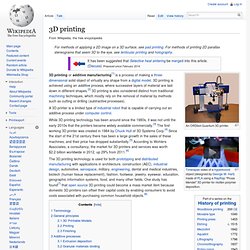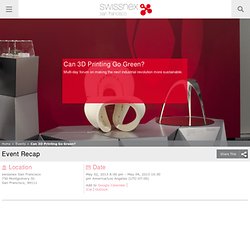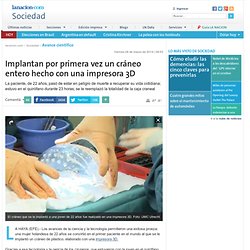

Additive Manufacturing - The Next Industrial Revolution. 3D printing. An ORDbot Quantum 3D printer. 3D printing or additive manufacturing[1] is a process of making a three-dimensional solid object of virtually any shape from a digital model. 3D printing is achieved using an additive process, where successive layers of material are laid down in different shapes.[2] 3D printing is also considered distinct from traditional machining techniques, which mostly rely on the removal of material by methods such as cutting or drilling (subtractive processes).

A 3D printer is a limited type of industrial robot that is capable of carrying out an additive process under computer control. The 3D printing technology is used for both prototyping and distributed manufacturing with applications in architecture, construction (AEC), industrial design, automotive, aerospace, military, engineering, dental and medical industries, biotech (human tissue replacement), fashion, footwear, jewelry, eyewear, education, geographic information systems, food, and many other fields. 3D Printed Biomaterial Implants. 3D Printed Biomaterial Implants. Can 3D Printing Go Green? It is clear there is a revolution going on in the do-it-yourself (DIY) or maker movement.

In fact, Chris Anderson, Wired Magazine’s former editor-in-chief, and others call it the new industrial revolution. At the heart of this revolution is micro-manufacturing, things like 3D printing that are quickly becoming accessible to anyone—and everyone. As 3D printing, and therefore rapid prototyping, reaches our desktops, millions of people are building what they want whenever they want it and innovation is moving at lighting speed. But with the growing revolution in 3D printing comes growing waste. How can we build integrated system solutions that favor recycling and sustainable, compostable materials (biomaterials) that still fulfill all the technical requirements to be used at the large-scale? Hear from leading scholars and entrepreneurs about the bright and sustainable future for in-home manufacturing.
Friday, May 3: Sustainable 3D Printing Summit, day-long workshop for 3D printing experts. Volledige kunststof 3D-geprinte schedel geïmplanteerd. Implantan por primera vez un cráneo entero hecho con una impresora 3D. LA HAYA (EFE).- Los avances de la ciencia y la tecnología permitieron una exitosa proeza: una mujer holandesa de 22 años se convirtió en el primer paciente en el mundo al que se le implantó un cráneo de plástico, elaborado con una impresora 3D.

Gracias a esa tecnología y la pericia de los cirujanos, que estuvieron con la joven en el quirófano durante 23 horas, la paciente pasó de estar en peligro de muerte a recuperar su vida cotidiana sin ningún tipo de dolencias. La cirugía la llevó a cabo el Hospital Universitario de Utrecht, en el centro de Holanda, que esperó a la recuperación definitiva de la enferma, que fue operada hace tres meses, para sacar la noticia a la luz. "Lo más novedoso es que implantamos la totalidad del cráneo, desde la frente hasta la nuca y de una oreja a la otra", explicó el cirujano que dirigió la operación, Bon Verweij, durante una entrevista.
Reconoció que ésta no fue la más difícil, aunque sí la "más creativa" de las intervenciones que hizo. Wearable Technology - Make It Wearable Challenge by Intel. 3d-babies. Project Daniel - Not Impossible's 3D Printing Arms for Children of War-Torn Sudan.